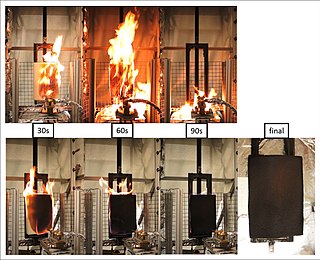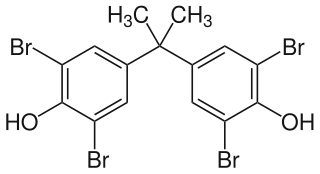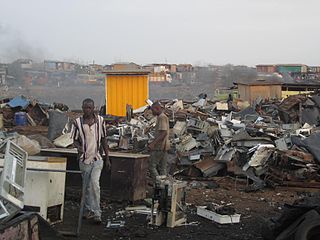Related Research Articles

Environmental laws are laws that protect the environment. Environmental law is the collection of laws, regulations, agreements and common law that governs how humans interact with their environment. This includes environmental regulations; laws governing management of natural resources, such as forests, minerals, or fisheries; and related topics such as environmental impact assessments.Environmental law is seen as the body of laws concerned with the protection of living things from the harm that human activity may immediately or eventually cause to them or their species, either directly or to the media and the habits on which they depend.
Polybrominated diphenyl ethers or PBDEs, are a class of organobromine compounds that are used as flame retardants. Like other brominated flame retardants, PBDEs have been used in a wide array of products, including building materials, electronics, furnishings, motor vehicles, airplanes, plastics, polyurethane foams, and textiles. They are structurally akin to polychlorinated diphenyl ethers (PCDEs), polychlorinated biphenyls (PCBs) and other polyhalogenated compounds, consisting of two halogenated aromatic rings. PBDEs are classified according to the average number of bromine atoms in the molecule. The health hazards of these chemicals have attracted increasing scrutiny, and they have been shown to reduce fertility in humans at levels found in households. Because of their toxicity and persistence, the industrial production of some PBDEs is restricted under the Stockholm Convention, a treaty to control and phase out major persistent organic pollutants (POPs).

The term flame retardant subsumes a diverse group of chemicals that are added to manufactured materials, such as plastics and textiles, and surface finishes and coatings. Flame retardants are activated by the presence of an ignition source and are intended to prevent or slow the further development of ignition by a variety of different physical and chemical methods. They may be added as a copolymer during the polymerisation process, or later added to the polymer at a moulding or extrusion process or applied as a topical finish. Mineral flame retardants are typically additive, while organohalogen and organophosphorus compounds can be either reactive or additive.

In organic chemistry, organophosphates are a class of organophosphorus compounds with the general structure O=P(OR)3, a central phosphate molecule with alkyl or aromatic substituents. They can be considered as esters of phosphoric acid.

Persistent organic pollutants (POPs) are organic compounds that are resistant to degradation through chemical, biological, and photolytic processes. They are toxic chemicals that adversely affect human health and the environment around the world. Because they can be transported by wind and water, most POPs generated in one country can and do affect people and wildlife far from where they are used and released.

A fire retardant is a substance that is used to slow down or stop the spread of fire or reduce its intensity. This is commonly accomplished by chemical reactions that reduce the flammability of fuels or delay their combustion. Fire retardants may also cool the fuel through physical action or endothermic chemical reactions. Fire retardants are available as powder, to be mixed with water, as fire-fighting foams and fire-retardant gels. Fire retardants are also available as coatings or sprays to be applied to an object.
The economic history of Nigeria falls into three periods. They are the: pre-colonial, the colonial and the post-colonial or independence periods. The pre-colonial period covers the longest the part of Nigerian history. The colonial period covers a period of 60 years, 1900-1960 while the independence period dates from October 1, 1960.
The Lower Guinean forests also known as the Lower Guinean-Congolian forests, are a region of coastal tropical moist broadleaf forest in West Africa, extending along the eastern coast of the Gulf of Guinea from eastern Benin through Nigeria and Cameroon.
Centre of West African Studies (CWAS) is a division of the School of Historical Studies at the University of Birmingham, England. The centre provides teaching and research into issues of African development, culture, anthropology, sociology, politics, history, and the legacies of the African diaspora, particularly in the UK, the Caribbean, and North America.

Tricresyl phosphate (TCP), is a mixture of three isomeric organophosphate compounds most notably used as a flame retardant. Other uses include as a plasticizer in manufacturing for lacquers and varnishes and vinyl plastics and as an antiwear additive in lubricants. Pure tricresyl phosphate is a colourless, viscous liquid, although commercial samples are typically yellow. It is virtually insoluble in water, but easily soluble in organic solvents like toluene, hexane, and diethylether among others. It was synthesized by Alexander Williamson in 1854 upon reacting phosphorus pentachloride with cresol, though today's manufacturers can prepare TCP by mixing cresol with phosphorus oxychloride or phosphoric acid as well. TCP, especially the all-ortho isomer, is the causative agent in a number of acute poisonings. Its chronic toxicity is also of concern. The ortho-isomer is rarely used on its own outside of laboratory studies that require isomeric purity, due to its extremely toxic nature, and is generally excluded from commercial products where TCP is involved.

Tetrabromobisphenol A (TBBPA) is a brominated flame retardant. The compound is a white solid, although commercial samples appear yellow. It is one of the most common flame retardants.

Triphenyl phosphate (TPhP) is the chemical compound with the formula OP(OC6H5)3. It is the simplest aromatic organophosphate. This colourless solid is the ester (triester) of phosphoric acid and phenol. It is used as a plasticizer and a fire retardant in a wide variety of settings and products.
Fire-safe polymers are polymers that are resistant to degradation at high temperatures. There is need for fire-resistant polymers in the construction of small, enclosed spaces such as skyscrapers, boats, and airplane cabins. In these tight spaces, ability to escape in the event of a fire is compromised, increasing fire risk. In fact, some studies report that about 20% of victims of airplane crashes are killed not by the crash itself but by ensuing fires. Fire-safe polymers also find application as adhesives in aerospace materials, insulation for electronics, and in military materials such as canvas tenting.

Agbogbloshie is a nickname of a commercial district on the Korle Lagoon of the Odaw River, near the center of Accra, Ghana's capital city in the Greater Accra region. Near the slum called "Old Fadama", the Agbogbloshie site became known as a destination for externally generated automobile and electronic scrap collected from mostly the western world. It was a center of a legal and illegal exportation network for the environmental dumping of electronic waste (e-waste) from industrialized nations. The Basel Action Network, a small NGO based in Seattle, has referred to Agbogbloshie as a "digital dumping ground", where they allege millions of tons of e-waste are processed each year.

Tris(1,3-dichloroisopropyl)phosphate (TDCPP) is a chlorinated organophosphate. Organophosphate chemicals have a wide variety of applications and are used as flame retardants, pesticides, plasticizers, and nerve gases. TDCPP is structurally similar to several other organophosphate flame retardants, such as tris(2-chloroethyl) phosphate (TCEP) and tris(chloropropyl)phosphate (TCPP). TDCPP and these other chlorinated organophosphate flame retardants are all sometimes referred to as "chlorinated tris".
Michael Mortimore was a British geographer and a prolific researcher of issues in the African drylands. He was an academic in Nigerian universities for over 25 years. He ran a British research consultancy, Drylands Research. He is best known for an anti-Malthusian account of population-environment relationships, More People, Less Erosion, and field-based studies of adaptation to drought.

Susan D. Shaw was an American environmental health scientist, marine toxicologist, explorer, ocean conservationist, and author. A Doctor of Public Health, she was a professor in the Department of Environmental Health Sciences at the School of Public Health at the State University of New York at Albany, and Founder/President of the Shaw Institute, a nonprofit scientific institution with a mission to improve human and ecological health through innovative science and strategic partnerships. Shaw is globally recognized for pioneering high-impact environmental research on ocean pollution, climate change, oil spills, and plastics that has fueled public policy over three decades. In 1983, with landscape photographer Ansel Adams, she published Overexposure, the first book to document the health hazards of photographic chemicals. Shaw is credited as the first scientist to show that brominated flame retardant chemicals used in consumer products have contaminated marine mammals and commercially important fish stocks in the northwest Atlantic Ocean. She became the first scientist to dive into the Gulf of Mexico oil slick following the 2010 BP Deepwater Horizon oil rig explosion to investigate the impacts of chemical dispersants used in response to the spill.
Silent Spring Institute is a nonprofit organization dedicated to studying and reporting primarily on breast cancer prevention, although its research covers other health-related topics as well.

The biogeographic regionalization of Earth's terrestrial biodiversity, known as Terrestrial Ecoregions of the World (TEOW), is made up of 867 ecoregions that are divided into 14 biomes. In addition to offering a comprehensive map of terrestrial biodiversity, TEOW also provides a global species database for ecological analyses and priority setting, a logical biogeographic framework for large-scale conservation strategies, a map for enhancing biogeographic literacy, and a foundation for the Global 200.

Bis(2-ethylhexyl)tetrabromophthalate (or TBPH), is a brominated phthalate derivative with the formula C24H34Br4O4 commonly used as a brominated flame retardant (BFR).
References
- ↑ "Reginald CLINE-COLE". Companies House . Retrieved 2 December 2023.
- ↑ "Dr Reginald Cline-Cole." School of History and Cultures, University of Birmingham. University of Birmingham, n.d. Web. 11 Nov. 2010. <http://www.historycultures.bham.ac.uk/staff/clinecole.shtml>.